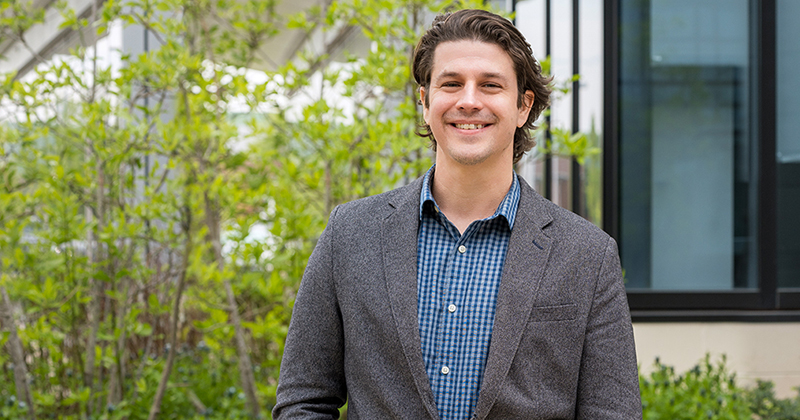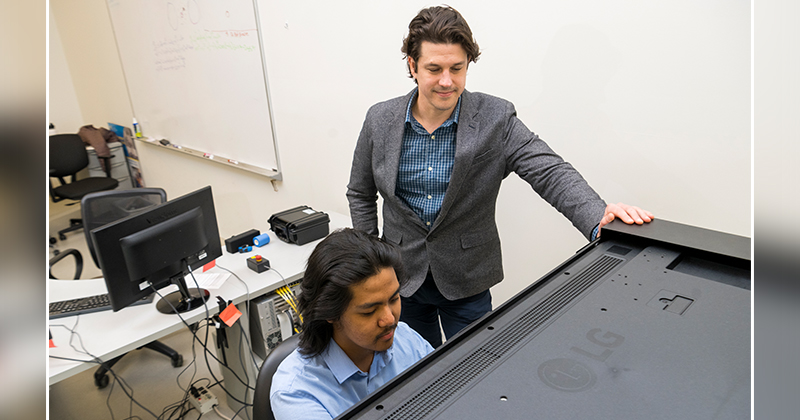


Mind and body
Photos by Kathy F. Atkinson June 23, 2023
UD engineering assistant professor Joshua Cashaback receives NSF CAREER award to study the connection between decision-making and movement control
From slamming on the brakes when the car in front of you stops suddenly to deftly avoiding a fallen branch on the sidewalk, we are constantly making decisions during motion. But while this type of rapid decision-making is essential for everyday function, it is still not fully understood how the brain and the body seamlessly work in unison to help us successfully navigate an ever-changing world.
Joshua Cashaback, assistant professor in the College of Engineering’s Department of Biomedical Engineering, is studying this interplay between decision-making and movement control as part of his biomechanics research program. Now, thanks to a Faculty Early Career Development Program (CAREER) award from the National Science Foundation (NSF), he and his lab will be delving further into this research area, with the long-term goal of using this knowledge to develop novel neurorehabilitation programs.
Fundamental research toward improving rehabilitation
After completing his doctorate in biomechanics, Cashaback became interested in the brain’s role in controlling movement and went on to complete a postdoc in sensory-motor control of human movement. He joined UD in 2019 and established his research group with the overarching goal of understanding how the body and the brain work together.
“The brain is the organ we know the least about, and it’s the brain that is controlling the biomechanics,” he said. “That’s why my group is studying motor control and learning, because that is an area where there are a lot of open questions. As part of that, we are trying to look at human behavior and infer what the nervous system is doing through movement.”
Cashaback’s research covers a number of themes and topic areas, from understanding how humans acquire new motor skills to how the nervous system reacts to the complex physics of movement in a way that is efficient and stable. His main area of interest is on reaching tasks, and his studies recruit both neurologically intact individuals as well as patients with neurological disorders such as Alzheimer’s and Parkinson’s diseases.
At his lab, located at the Health Sciences Complex on Science, Technology and Advanced Research (STAR) Campus, volunteers complete reaching tasks using a virtual-reality and robotic device that records their movements and reactions. And while his research is largely fundamental, he said, the goal is to use knowledge of how neural and muscular systems work together to help design new rehabilitation strategies for patients with neurological disorders.
“Throughout my career, I’ve always done basic science. The nice thing about working here is that there's a lot of clinician scientists that I've been able to work with, which has expanded my research program,” he said about what attracted him to establish his lab UD.
Decision-making and movement control
Thanks to the five-year, $594,491 award from NSF, Cashaback’s lab will delve further into how decision-making and movement are connected. Cashaback said that what’s innovative about this CAREER award project is its focus on the real-time interplay between decision-making and movement control.
“Other groups have largely done discreet decision-making experiments — a classic example of an experiment is where you have dots on a screen and the individual chooses whether they are moving left or right,” he said. “But those experiments are not really focused on the movement, but primarily the decision. With this CAREER award, we’ll combine both ideas and look at how continuously changing evidence impacts movement in real time.”

Doctoral student Jan Calalo will conduct this research, which will include new experiments on neurologically intact individuals as well as patients with mild cognitive impairments and Alzheimer's disease through a collaboration with the Delaware Center for Cognitive Aging Research. The data from these experiments will be analyzed using advanced computational models that incorporate knowledge from both decision-making and movement control literature to gain a better understanding of how these two processes influence one another.
“The goal is to predict what people are going to decide based on their movements — before they even consciously make a decision,” Cashaback said about the anticipated results of this work. He added that by understanding the mechanism of how decision and motor circuits interact, they can use this knowledge to better diagnose or rehabilitate patients in the future.
“There are a number of neurological disorders, such as stroke, Parkinson's, Alzheimer’s and even just natural aging, where there's not only deficits to the motor system or the cognitive system, but to both systems,” Cashaback said. “With this project, we will be taking these reaching tasks to see if we can dissociate to what degree they have cognitive impairments or motor impairments, and what kind of rehabilitation strategies we can use to help them.”
STEM inspiration
This NSF CAREER award also supports new and ongoing STEM outreach activities, including the Brains, Action, Integrative Neurorehabilitation (BRAIN) Day. Cashaback organized this outreach event for students from West Park Place Elementary, with the goal of helping students learn about how the nervous and muscular systems work together and how understanding those interactions can help improve mobility and quality-of-life for patients with neurological disorders.
On June 2, a group of 45 fifth graders attended the inaugural Brain Day. Students visited several labs at the Health Sciences Complex, including the Human Robotics Lab, the Control of Balance and Locomotion Lab and the Neuromuscular Biomechanics Lab. Students were able to try out the adaptive treadmills that researchers use for gait studies as well as the robotic exoskeletons used for reaching rehabilitation. Calalo, who helped organize Brain Day, said that the students’ feedback was very positive and that they plan to host this event again next year.
Cashaback is also working with Jennifer Semrau in the College of Health Sciences Department of Kinesiology and Applied Physiology to develop free, open-access educational games, with the goal of raising awareness about neurological disorders while also inspiring a new, diverse generation of scientists and engineers. This work includes the development of an app where students can complete different motor tasks, learn about what regions of the brain control motion, and how movement is impacted in patients with different neurological disorders.
“Professor Cashaback’s interdisciplinary approach to understanding both the cognitive and motor contributions to human motion stands to inform new rehabilitation strategies,” said Kristi Kiick, chair of the Department of Biomedical Engineering and Blue and Gold Distinguished Professor of materials science and engineering. “His additional interests in education, from the elementary to graduate level, are palpable, and he is an outstanding educator and mentor. His recognition with the NSF CAREER Award is most deserved, and we are delighted to have him as a colleague in BME.”
For Cashaback, who was initially attracted to bioengineering because of his interests in physics and sports, working in a branch of sensorimotor control that allows him to gain new insights into how the brain and the body work together is what keeps him motivated. Now, thanks to this CAREER award, his research is poised to continue making an impact on future treatment paradigms.
“By gaining mechanistic knowledge of how decision and motor circuits interact, we can better inform rehabilitation programs to either diagnose or rehabilitate people with different neurological disorders like Alzheimer’s, Parkinson’s or stroke,” he said.
Contact Us
Have a UDaily story idea?
Contact us at ocm@udel.edu
Members of the press
Contact us at 302-831-NEWS or visit the Media Relations website

